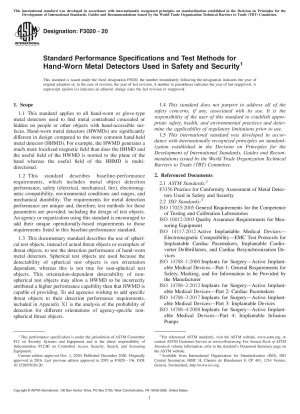ASTM F3020-20
Standard Performance Specifications and Test Methods for Hand-Worn Metal Detectors Used in Safety and Security
- Standard No.
- ASTM F3020-20
- Release Date
- 2020
- Published By
- American Society for Testing and Materials (ASTM)
- Latest
- ASTM F3020-20
- Scope
- 1.1 This standard applies to all hand-worn or glove-type metal detectors used to find metal contraband concealed or hidden on people or other objects with hand-accessible surfaces. Hand-worn metal detectors (HWMDs) are significantly different in design compared to the more common hand-held metal detector (HHMD). For example, the HWMD generates a much more localized magnetic field than does the HHMD and the useful field of the HWMD is normal to the plane of the hand whereas the useful field of the HHMD is multidirectional. 1.2 This standard describes baseline-performance requirements, which includes metal object detection performance, safety (electrical, mechanical, fire), electromagnetic compatibility, environmental conditions and ranges, and mechanical durability. The requirements for metal detection performance are unique and, therefore, test methods for these parameters are provided, including the design of test objects. An agency or organization using this standard is encouraged to add their unique operationally-based requirements to those requirements listed in this baseline-performance standard. 1.3 This documentary standard describes the use of spherical test objects, instead of actual threat objects or exemplars of threat objects, to test the detection performance of hand-worn metal detectors. Spherical test objects are used because the detectability of spherical test objects is not orientation dependent, whereas this is not true for non-spherical test objects. This orientation-dependent detectability of nonspherical test objects may allow a HWMD to be incorrectly attributed a higher performance capability than that HWMD is capable of providing. To aid agencies wishing to add specific threat objects to their detection performance requirements, included in Appendix X1 is the analysis of the probability of detection for different orientations of agency-specific nonspherical threat objects. 1.4 This standard does not purport to address all of the safety concerns, if any, associated with its use. It is the responsibility of the user of this standard to establish appropriate safety, health, and environmental practices and determine the applicability of regulatory limitations prior to use. 1.5 This international standard was developed in accordance with internationally recognized principles on standardization established in the Decision on Principles for the Development of International Standards, Guides and Recommendations issued by the World Trade Organization Technical Barriers to Trade (TBT) Committee.
ASTM F3020-20 Referenced Document
- ASTM F3356 Standard Practice for Conformity Assessment of Metal Detectors Used in Safety and Security
- IEEE C95.1 Military Workplaces-Force Health Protection Regarding Personnel Exposure to Electric@ Magnetic@ and Electromagnetic Fields@ 0 Hz to 300 GHz
- IEEE C95.6 IEEE standard for Safety Levels with Respect to Human Exposure to Electromagnetic Fields@ 0-3 kHz (IEEE Standards Coordinating Committee 28)
ASTM F3020-20 history
- 2020 ASTM F3020-20 Standard Performance Specifications and Test Methods for Hand-Worn Metal Detectors Used in Safety and Security
- 2019 ASTM F3020-19a Standard Performance Specifications and Test Methods for Hand-Worn Metal Detectors Used in Safety and Security
- 2019 ASTM F3020-19 Performance Standard for Hand-Worn Metal Detectors Used in Safety and Security
- 2016 ASTM F3020-16 Performance Standard for Hand-Worn Metal Detectors Used in Safety and Security
